Vancouver Island is a renowned hiking destination, and for good reason. The Island offers an array of hiking experiences, whether you’re exploring the stunning sandy beaches of Pacific Rim National Park Reserve, hurting your neck looking up at the giant trees in Cathedral Grove, tackling the challenging rugged coastal terrain of the North Coast Trail, or enjoying the panoramic views from the peaks around Strathcona Provincial Park. While easily as beautiful as many other Canadian tourism destinations, many areas on the Island are uniquely rugged, and preparation is essential before heading out into the wilderness.
If you’re wondering if you should hike Vancouver Island, the answer is yes! I’ve shared my top tips for having fun (and being safe) while on the trail. See you out there!
- Research Your Route
- Check Weather Conditions
- Be Wildlife Aware
- Pack Essentials
- Safety in Numbers
- Cell Service Caution
- Practice Good Trail Etiquette
- Know Your Limits
- Food and Hydration
- Leave No Trace
- Plan According to the Seasons
- Prepare for Logging Roads
- Be Aware of Tides
- Wear Hiking Boots or: How I Learned to Stop Worrying and Love the Bog
- Use these Recommended Resources
Research Your Route
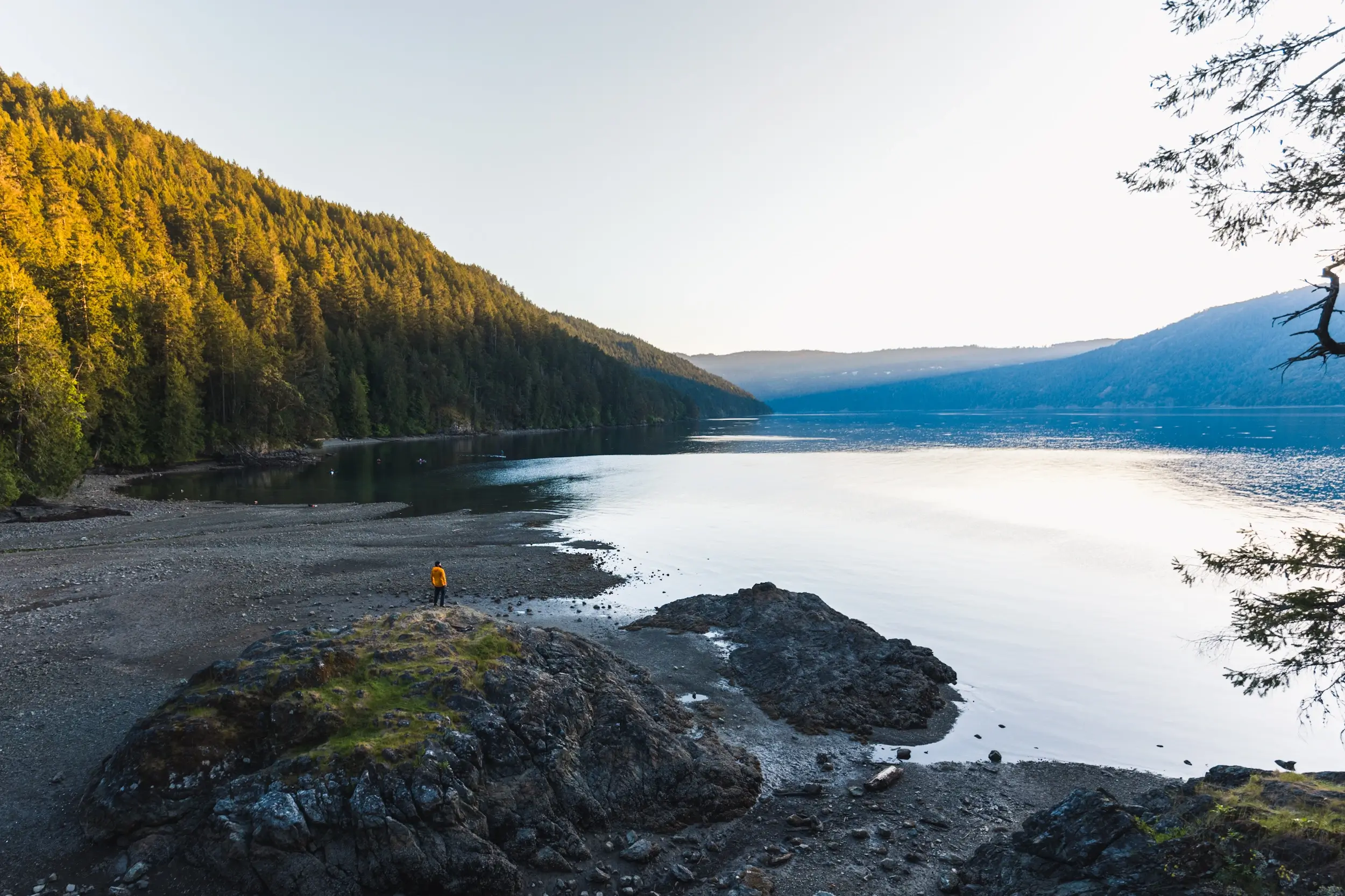
Mckenzie Bight, one of the best hikes near Victoria
Some of Vancouver Island’s hikes are inside national and provincial parks, but many are not, meaning signage and trail maintenance can range anywhere from excellent to completely nonexistent. That’s why it’s important to know in advance what you’re getting into when picking a Vancouver Island hike. Gather detailed information ahead of time on trail length, elevation gain, difficulty, as well as looking up the weather and logistics of getting to the trailhead itself. Everyone has different ability levels, so a trail that’s right for someone else might not be right for you. While I don’t necessarily recommend using Alltrails as your only source of information, it is super useful for seeing recent trail reviews in order to get up-to-date info on a particular trail.
There are tons of online and print resources for learning about Vancouver Island hikes, including of course this website where I try to cover as many hikes as I can. I’ve also linked to a bunch of other great resources further down this list.
Check Weather Conditions
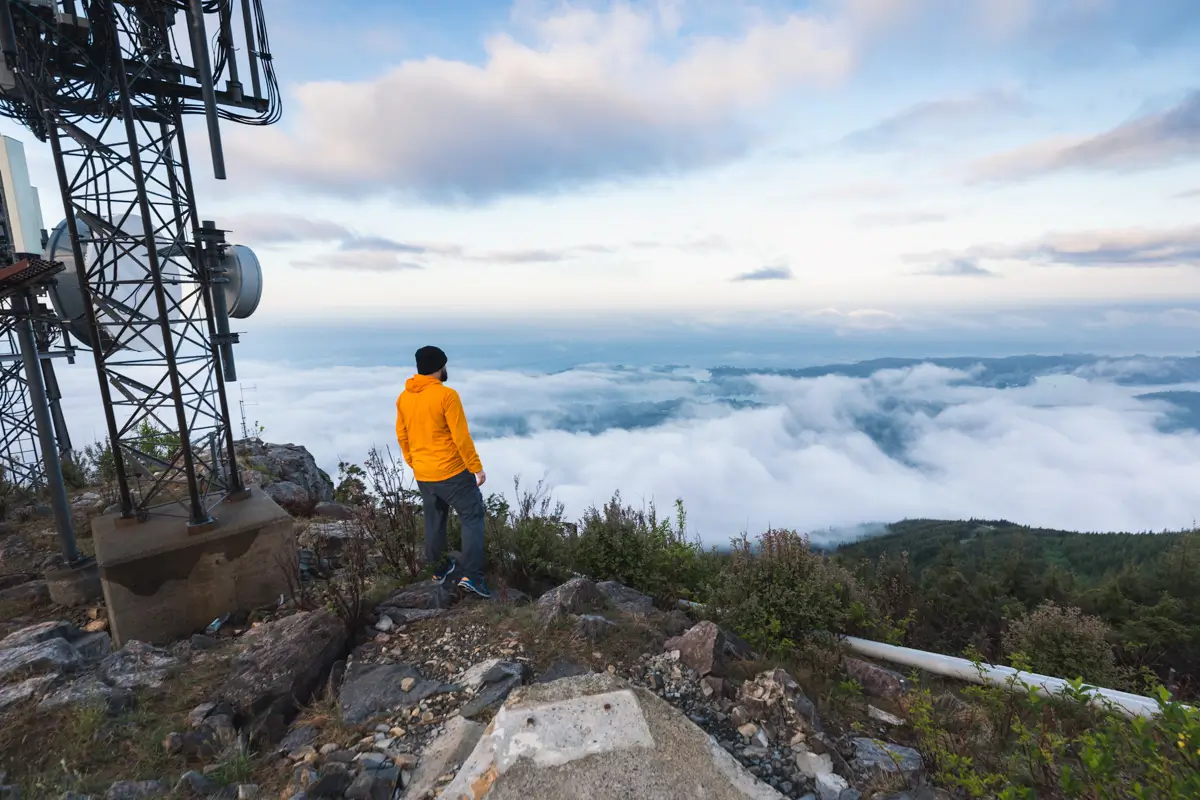
The view from the Mt Ozzard viewpoint above Ucluelet
Vancouver Island’s weather can change rapidly, and often conditions can be very different in different parts of the Island. Sun shining in Victoria? There’s still a good chance it’s raining in Tofino and foggy in Port Alberni. Get high enough in the mountains and it just might be snowing.
So it’s essential to check the forecast before you head out and prepare for diverse conditions, because that forecast can still change. Carrying waterproof gear, dressing in layers, and having a plan for sudden weather changes are all smart choices while exploring Vancouver island’s hiking trails. Read more about Vancouver Island’s weather throughout the year here.
Be Wildlife Aware
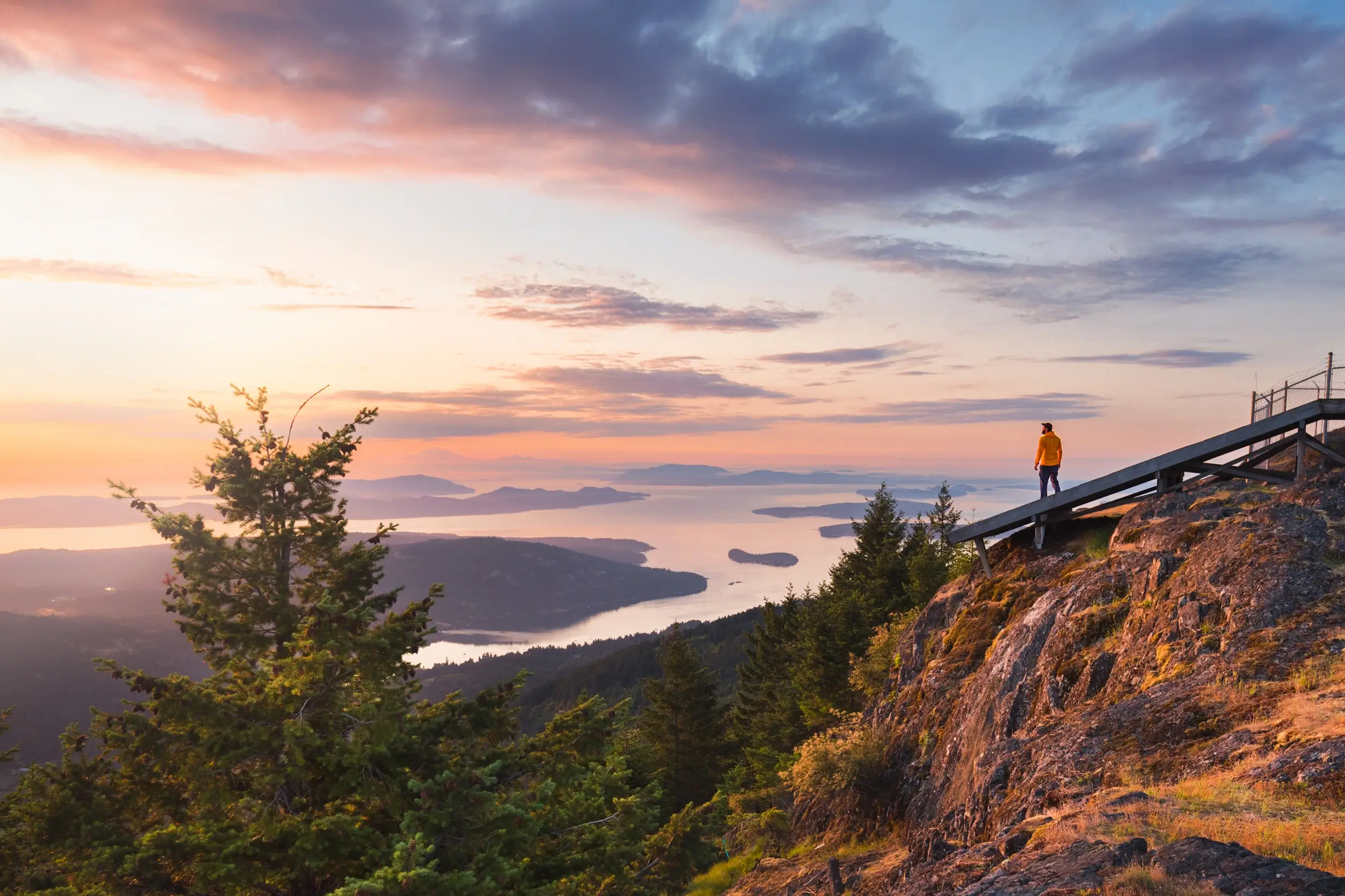
Mt Bruce, the highest point in the Gulf Islands, offers unparalleled views of the rest of the islands
Vancouver Island is home to a variety of wildlife, including bears, cougars, and a huge range of bird and marine life. Of course one of the draws to the Island is the opportunity to see some of these beautiful animals, but it’s also important to be safe and respectful. Maintain a respectful distance from wildlife, and never ever feed the animals. It may seem kind but it doesn’t just kill wildlife and put people in danger, it’s also in many cases illegal. Store food securely and manage waste to avoid attracting animals to your campsite or trail. Bear bells are proven to be an ineffective bear deterrent, and are even actively discouraged by Parks Canada. The best way to let bears know you’re around is simply to use your voice. Understanding and respecting the wildlife on Vancouver Island not only protects you but also contributes to the conservation of these species and their environment.
Pack Essentials
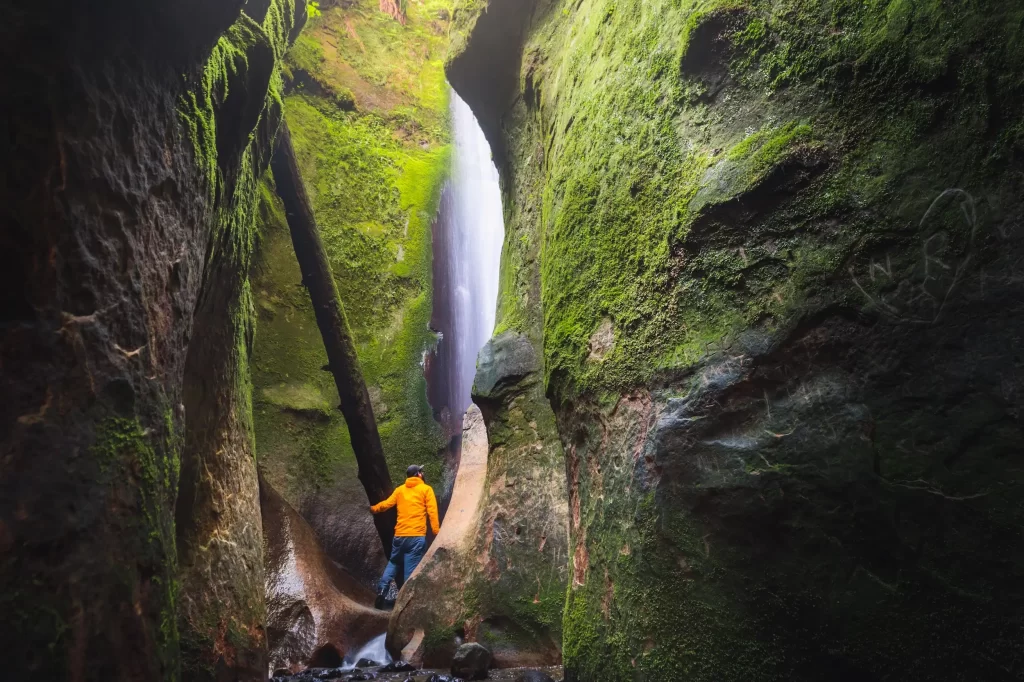
The Sombrio Hidden Falls is one of the most beautiful places on Vancouver Island, but the canyon is also sadly full of graffiti
When hiking on Vancouver Island, packing the essentials is key to risk mitigation, especially given the island’s unpredictable weather and remote areas where help is rarely close by. While most of the “ten essentials” don’t get used by most hikers on most hikes, if you’re in the situation where one of them does become truly essential and you didn’t pack it, you’re probably in trouble.
Most experienced hikers assess conditions and don’t necessarily carry all of the ten essentials at all times. I won’t pretend I do. That said, I’ve also been in situations where I forgot to bring certain essentials and really needed them (1, 2, 4, 5, and 9 if you’re interested). Fortunately I was able to make it out of those situations either by the skin of my teeth or with help from another hiker, but I really really would not like to find myself in any of those potentially life-threatening situations again, so I try to pack more wisely nowadays. If you want to be smarter than me, consider packing the following.
1. Navigation: Think map, compass, GPS device, and possibly an altimeter, but most important are the skills to use these tools. Apps on your phone are great, but traditional navigation tools still have value for route finding and preventing getting lost, especially where signals might fail or batteries might run out.
2. Sun Protection: Protect yourself from the sun with sunglasses, sunscreen, and a hat. Sunburn and UV exposure can cause severe skin damage and increase the risk of heat stroke. Combine a lack of sun protection with a lack of water on a hot summer’s day, and you might be in trouble.
3. Warm Layers: Additional clothing layers can be a lifesaver when dealing with rapidly changing weather conditions. This is particularly vital in Vancouver Island’s alpine where temperatures can plummet dramatically when the sun goes down.
4. Illumination: Carry a headlamp or flashlight with extra batteries. Illumination is vital for navigating or setting up camp in the dark, and it is indispensable in case of an unexpected night out. I’ve hurt myself while hiking before, and even though I had planned on making out during daylight, I didn’t make it back until night. If I hadn’t had a light I would have been screwed.
5. First Aid Supplies: A well-stocked first aid kit is crucial for treating injuries and illnesses on the trail. Having the means to respond to medical situations quickly can prevent them from worsening, which is especially important when help isn’t anywhere nearby (It’s usually not).
6. Fire: Essentials for making a fire include matches, a lighter, and a waterproof container; a firestarter is also highly recommended. A fire serves multiple survival purposes, including warmth, the ability to cook, and emergency signaling. Bear in mind that this is strictly for survival situations; fires are often not allowed during the summer, and are never allowed in provincial and national parks.
7. Repair Kit and Tools: A multi-tool and repair kits for gear can save the day when equipment breaks. This is key for self-sufficiency in remote areas where replacements aren’t available.
8. Nutrition: Pack extra food, enough for at least an additional day beyond your planned trip. Having sufficient nutrition is critical for maintaining energy and safety, especially if you’re delayed or stranded.
9. Hydration: It’s essential to carry water and a water purification system. While much of Vancouver Island is rainforest, with plenty of water sources available, there are also many hikes which do not have water sources available, so this is something to research ahead of time. I’ve experimented with a few water filters, with my go-to nowadays being the Katadyn BeFree.
10. Emergency Shelter: Items like a space blanket, tarp, or bivy sack can be lifesaving when forced to spend an unexpected night outdoors, providing protection from harsh weather conditions and can help to prevent hypothermia.
Safety in Numbers
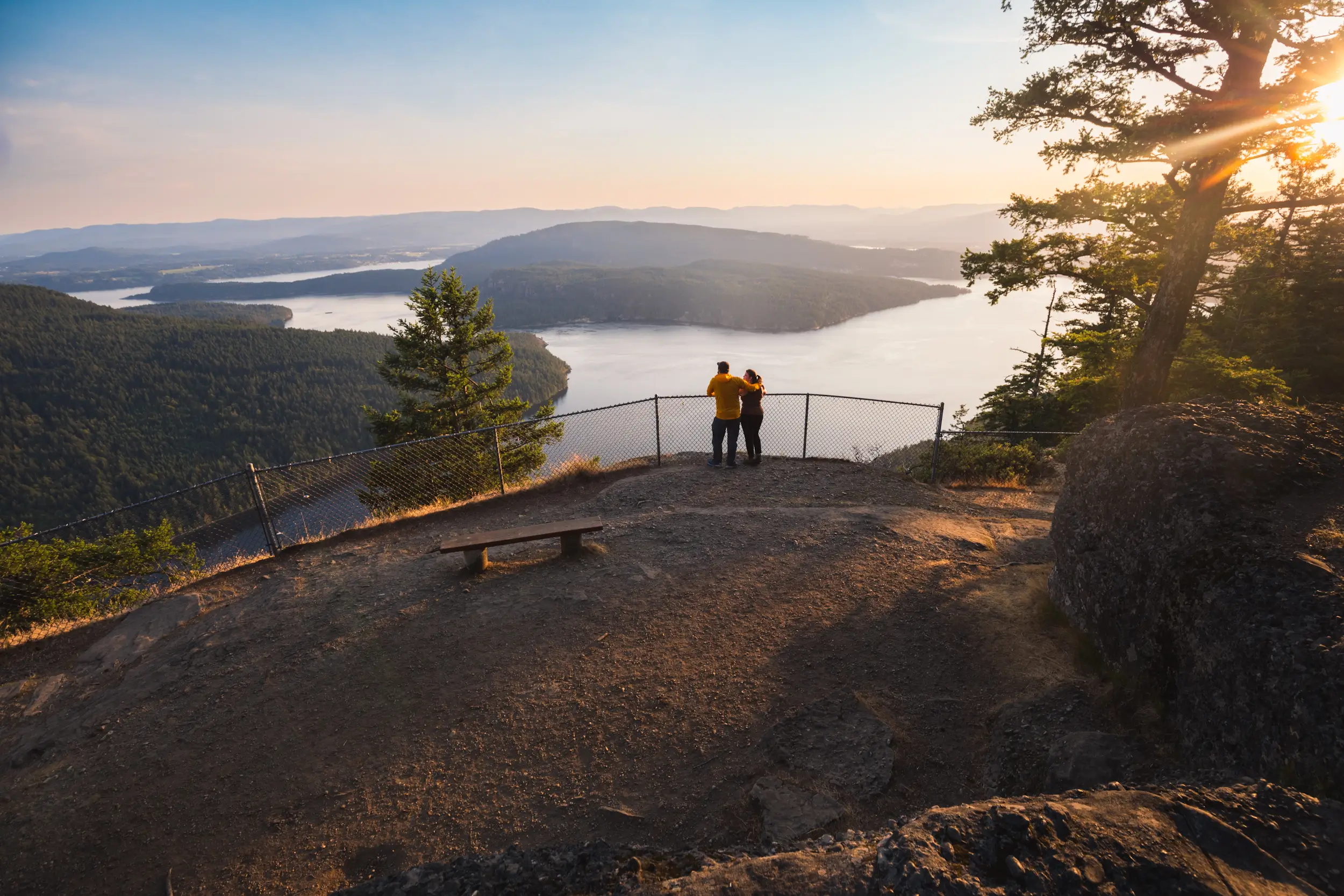
Baynes Peak is one of the most beautiful hikes on Salt Spring Island
Hiking Vancouver Island’s trails with a companion not only makes for double the fun but also significantly increases your safety. In the event of an unexpected situation, having someone with you can make a crucial difference, whether it’s providing immediate assistance or getting help.
That said, if you’re like me and either prefer the solitude of hiking alone or don’t have anyone to hike with, it’s imperative to share your plans with someone before you depart. This includes detailing your intended route, expected return time, and any other relevant information that could assist in locating you if you don’t return as planned. That way even when you’re alone, someone is aware of your whereabouts and can initiate a timely response if necessary.
Cell Service Caution
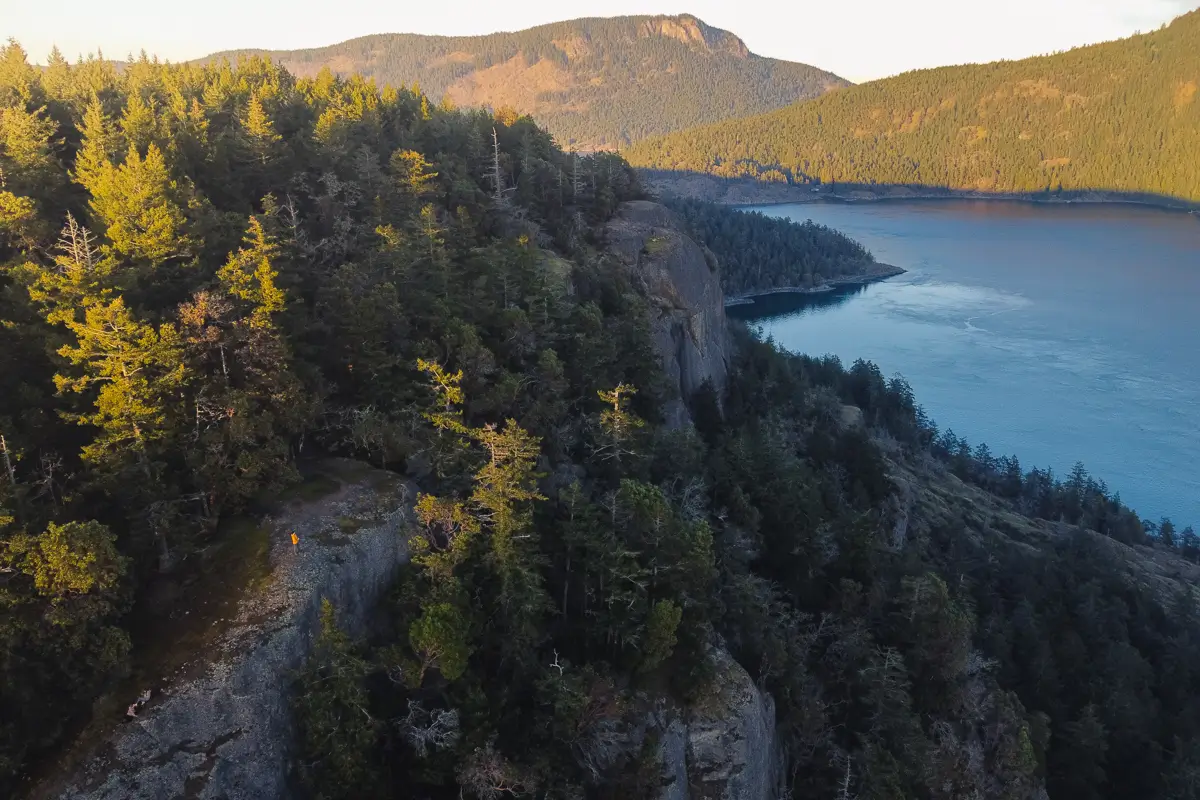
Looking down from one of many viewpoints along the Stoney Hill hike
Vancouver Island’s small logging towns and remote mountain forests are infamous for their lack of cell reception. In fact, you only need to drive an hour out of Victoria in the right direction to lose service. This is why it’s super important not to rely on having internet for navigation or emergency communication. Before heading out, download offline maps and familiarize yourself with your route. If I’m using resources on my phone to help me on a hike, I make sure to screenshot everything before I leave to make sure I have a copy on my device. Though it is an investment, consider carrying a satellite messenger or personal locator beacon, especially when venturing into more isolated areas.
Practice Good Trail Etiquette

Views from the viewpoint near the summit of Mt Tzouhalem near Duncan.
In my experience the friendliness of hikers on trails tends to be directly proportionate to the accessibility of the trail they’re on. Typically in the backcountry hikers passing each other on the trail will greet each other, with anything less than a head nod and an out-of-breath smile being considered inconceivably rude. In more “tourist” hiking destinations like certain national parks, where hikers may have less experience with trail etiquette, it seems common for hikers to rudely barge straight past without any greeting or eye contact at all.
Greeting each other on the trail is an important part of trail etiquette, and it has to do with more than just politeness – it’s also about being safe. If you should get lost or hurt, it’s helpful to have someone remember seeing you on the trail, and where you were. We all look out for each other out there, and greeting each other creates a sense of community and safety. I’ve had people stop to ask me questions about the trail after I had greeted them, and if I hadn’t shown first that I was friendly they might not have felt comfortable doing so.
If you’re hiking in a group, avoid spreading out and causing trail erosion by walking single file, especially in sensitive environments. When you meet hikers coming the other direction, both parties should look at the trail to see who should step to the side, causing the least disturbance to the trail. Usually there’s an obvious best spot for someone to step aside without crushing plants and widening the trail unnecessarily. Keep your pets under control, ideally on a leash, and always clean up after them to keep the trails clean for others. As well, avoid loud music or noises that could disturb wildlife or other hikers’ experience. When I encountered a group of hikers blasting their stereo into the woods they might not have realized it but they were ruining dozens of other peoples’ experiences. By following these trail etiquette guidelines, you avoid being rude, and make people feel safer and more welcome on Vancouver Island’s trails.
Know Your Limits
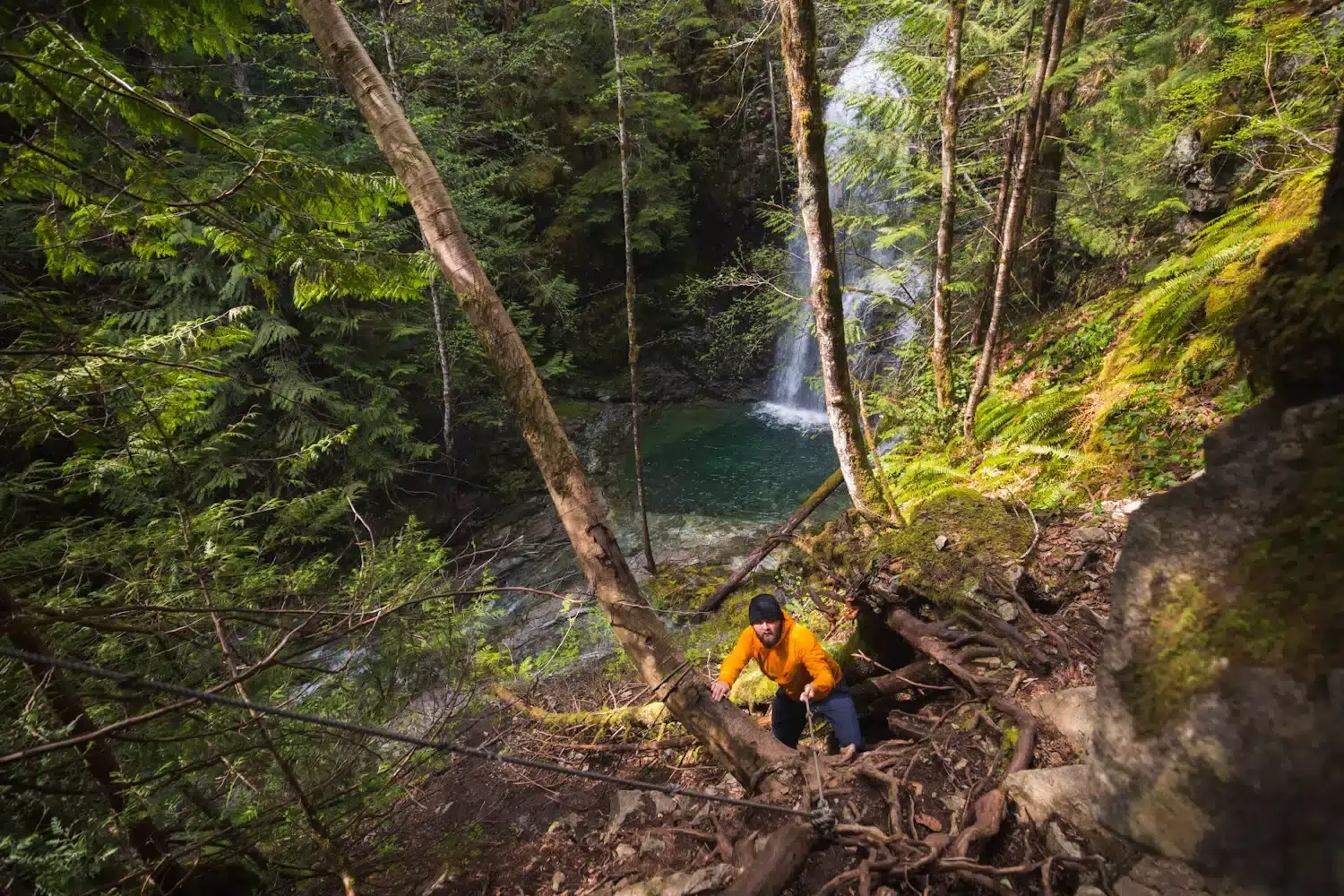
A slightly challenging rope-aided downclimb to Weiner Falls near Port Alberni
Trails on Vancouver island can range from leisurely walks to challenging multi-day treks, so understanding your physical fitness level, hiking experience, and comfort with various terrains is pretty important when it comes to choosing a trail. Start with shorter, less challenging hikes and gradually build up to more strenuous treks. When I first started hiking my research included a whole bunch of long challenging hikes that I was totally sure I could do, but when I tried to actually do some of them it was a real reality check. Always assess the trail’s difficulty, length, elevation gain, and estimated completion time to ensure it aligns with your abilities. It’s better to overestimate the trail’s difficulty and be pleasantly surprised than to underestimate it and find yourself in a challenging situation. And if you do find yourself out of your depth, it’s important to know when to call it and turn back around. If you’re new to hiking or unfamiliar with the island’s trails, consider joining a guided hike or a local hiking group.
Food and Hydration
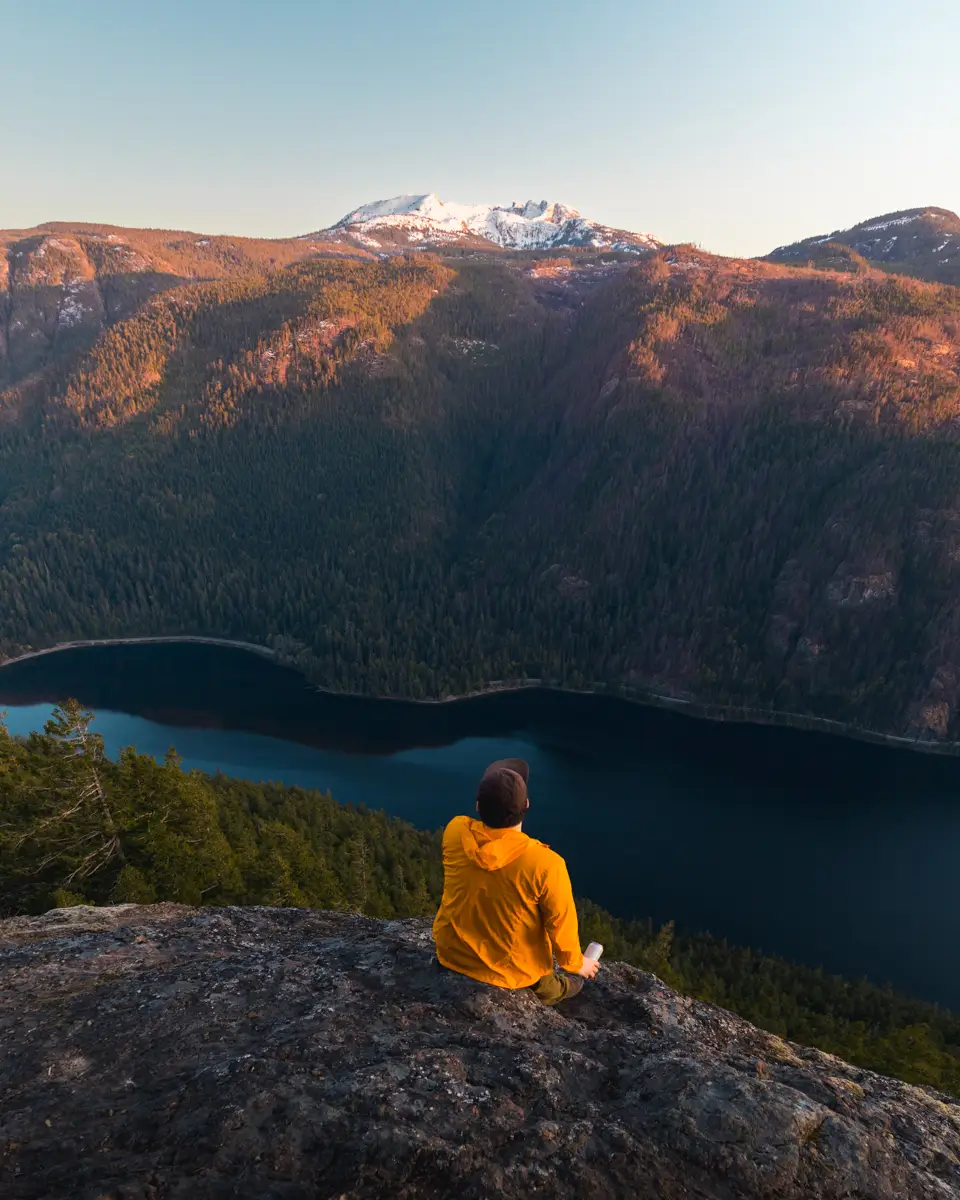
Spectacular views of distant Mt Arrowsmith from a viewpoint near the summit of Wesley Ridge
Bring. Water. Bring water.
You’ve got to make sure to get enough water to stay hydrated throughout your hike; dehydration can lead to fatigue and impair judgment. While it’s possible to rely on water sources along the trail, make sure you find out ahead of time a) where those water sources are, and b) if those creeks are still flowing at that particular time of year. I know not everyone uses a water filter, but beaver fever is still common in water sources in Western Canada. I use the Katadyn BeFree and it weighs less than my normal water bottle, so it’s honestly more convenient to bring along than not.
When it comes to food, opt for high-energy, nutrient-dense snacks like nuts, seeds, energy bars, and dried fruit, which can help maintain your stamina. For longer hikes, include more substantial meals to replenish your energy. It’s also a good idea to carry a little extra food than you anticipate needing in case your hike takes longer than expected.
Leave No Trace
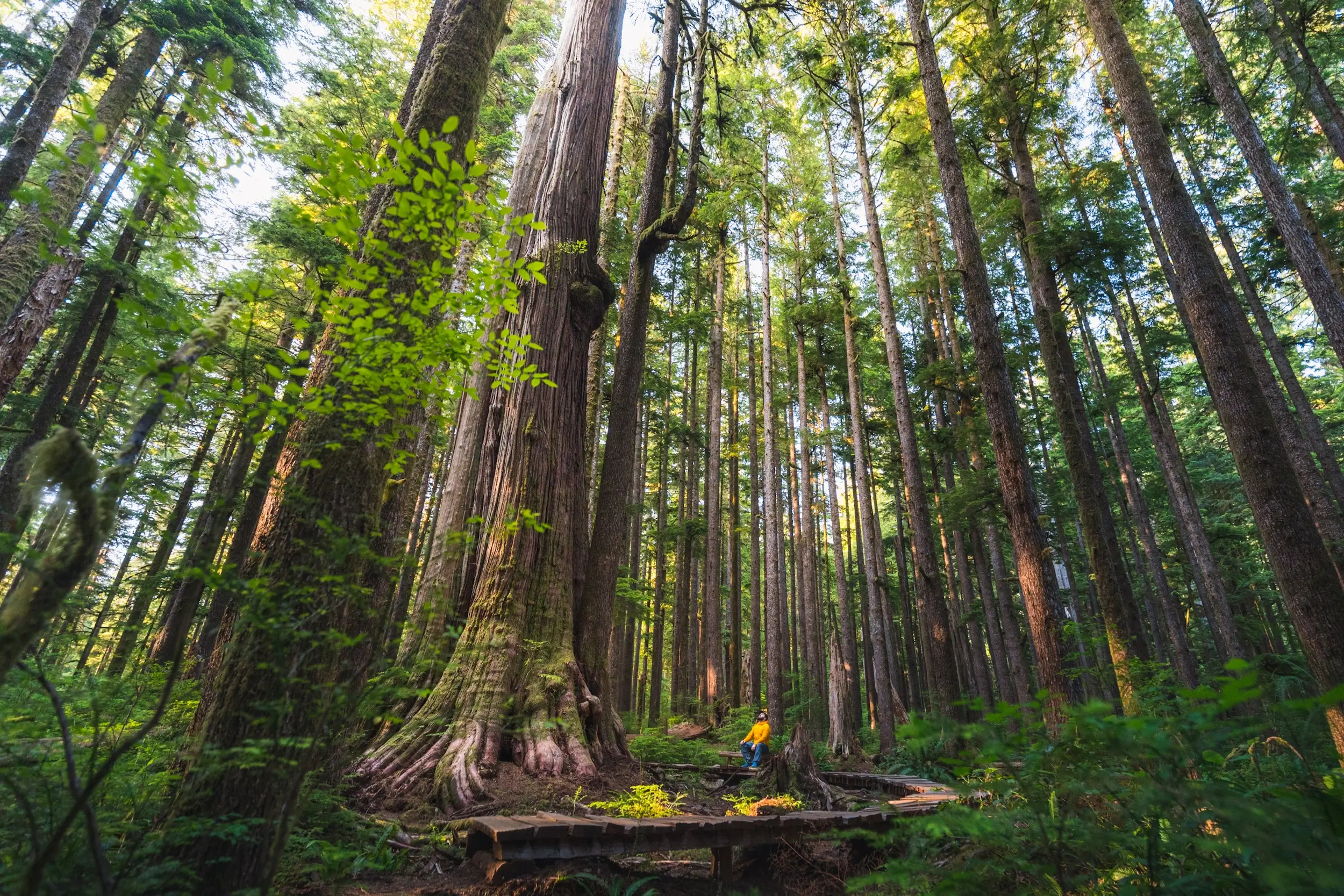
Admiring one of the many old-growth giants in Port Renfrew’s Eden Grove
Practicing “Leave No Trace” principles is just obvious while hiking on Vancouver Island, ensuring the preservation of the beautiful environments that you’re here to enjoy are still just as beautiful for hikers in ten years time. Many behaviours which don’t really have much impact or do much damage on their own compound, and if enough hikers do them they lasting negative impacts. The island’s unique ecosystems, many of which are quite fragile, require conscientious hiking behaviors to minimize human impact. Always pack out what you pack in, including all trash, leftover food, and litter. Stay on designated trails to avoid trampling undergrowth and causing erosion, especially in sensitive areas like meadows. When camping, use existing sites and avoid creating new ones. Finally, Be mindful of wildlife by observing from a distance and never feed animals, as this can alter their natural behaviors and habitats.
Oh, and if you leave bags of dog poo on trails then you’re the worst kind of hiker and we all hate you. Don’t do that. Seriously. What kind of person does that.
Plan According to the Seasons
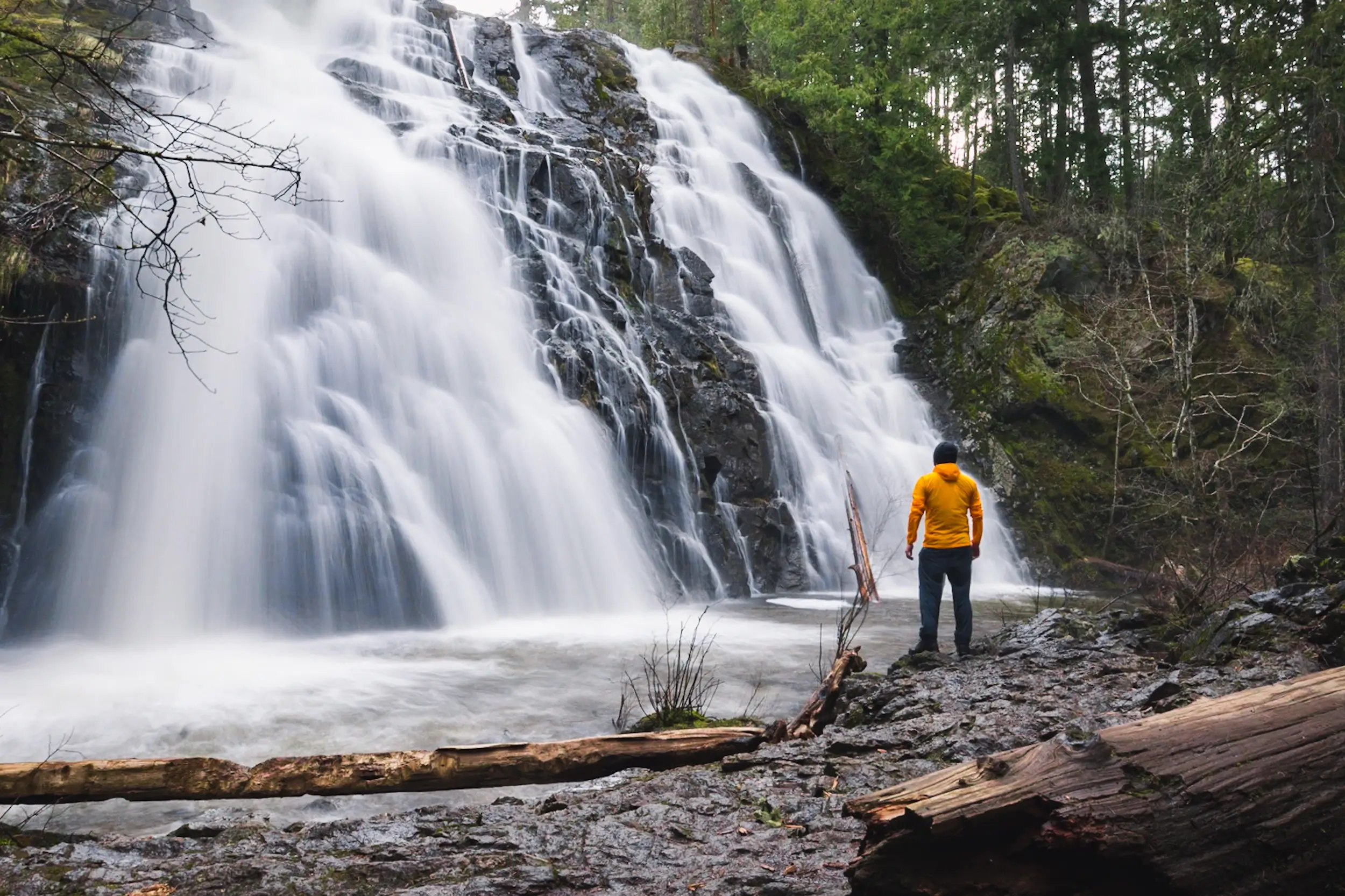
Greater Christie Falls, one of my favourite Vancouver Island waterfalls
Summer on Vancouver Island offers the best conditions for getting up in the mountains with warm weather and long sunny days, ideal for accessing high-altitude trails that are covered in snow the rest of the year. Just make sure you’re prepared for the heat, and the potential for wildfire smoke.
On the other hand, winter is the ideal time of year for visiting Vancouver Island waterfalls. This rainy time of year means all of the Island’s creeks and rivers are rushing with water, and the waterfalls at their most dramatic.
Each season has its unique appeal and challenges, so select based on your preferences for weather, trail conditions, and desired scenery, always checking local conditions before your hike.
Prepare for Logging Roads
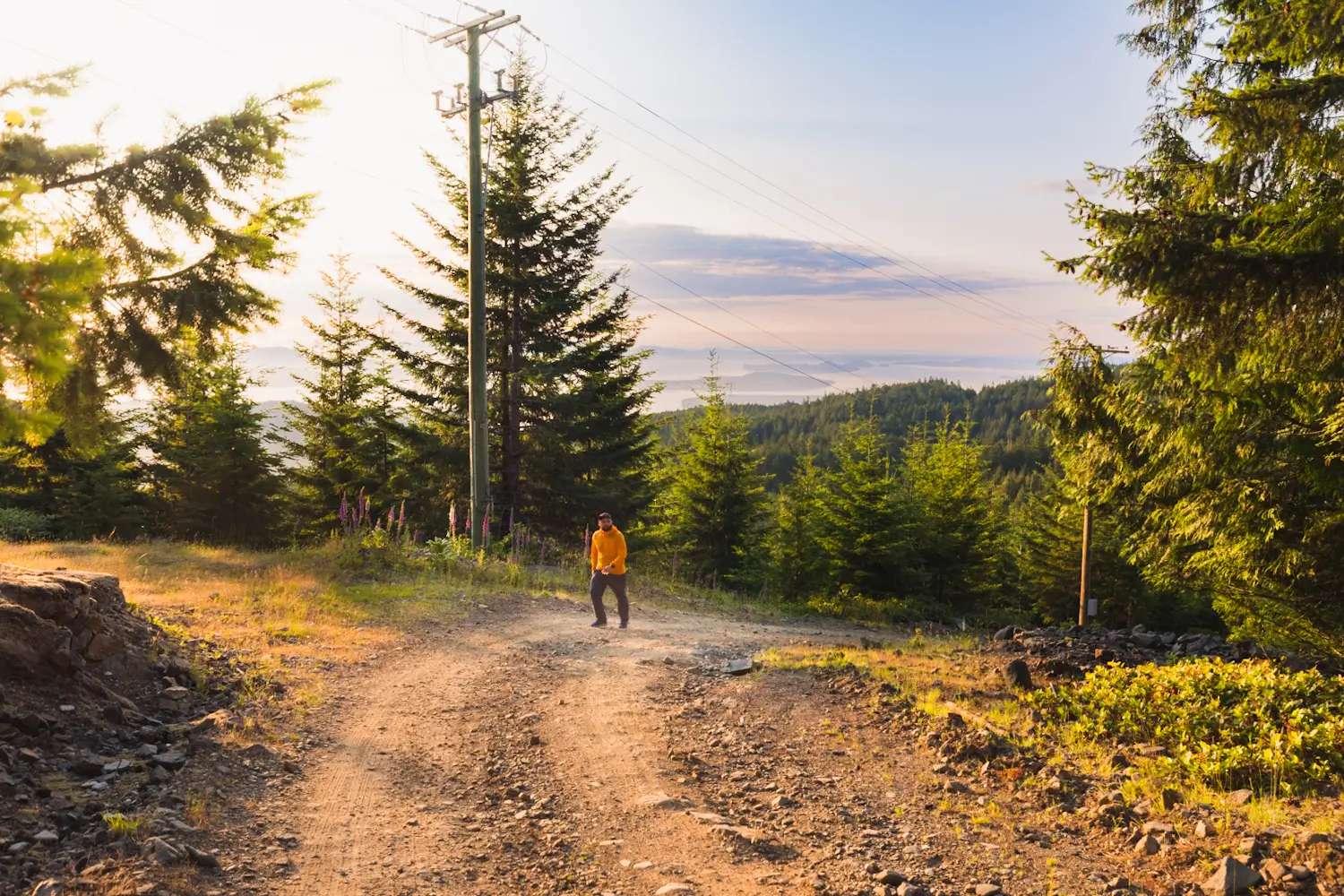
When exploring Vancouver Island’s backcountry it’s common to use logging roads, as the Island’s active logging industry is often the only human presence. These roads can vary in condition from well-maintained gravel roads to overgrown and complex defined maze-like paths. Google Maps does not map these roads (not that you’ll have cell service), and signage is nil, so lots of preparation is required. In addition to a map and directions, be prepared to get a flat tire or find the exit road blocked by a fallen tree, and know what to do in these situations.
Tensions between loggers are “treehuggers” are not great, especially due to recent protests against the logging of old growth rainforest on Vancouver Island. While some loggers won’t mind your presence on these roads, it’s also possible to encounter aggressive ones. Make sure to get out of the way of logging trucks – you can slow down a lot faster than they can.
Be Aware of Tides
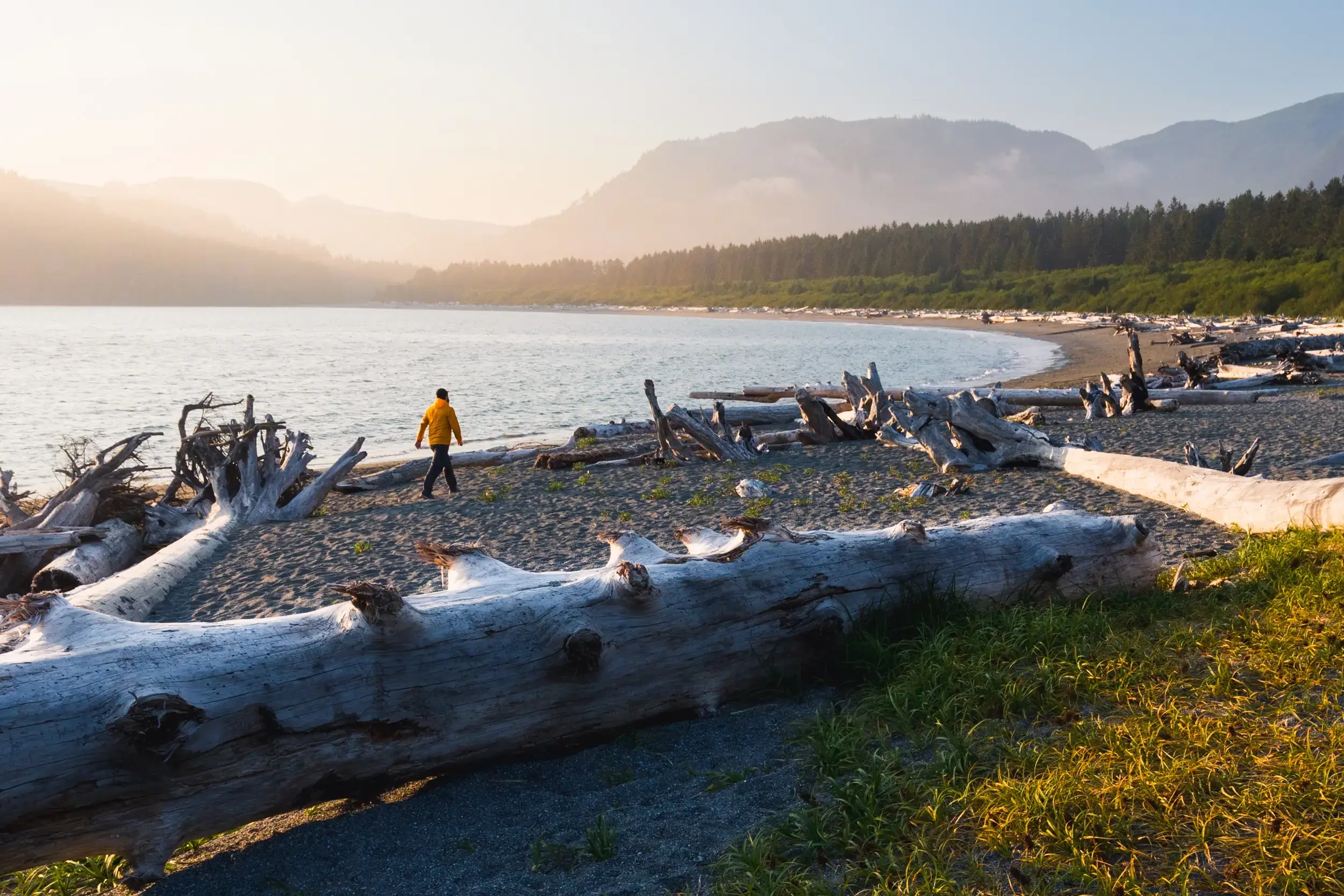
Pacheedaht Beach is an easily accessible beach just outside Port Renfrew
Vancouver Island has spectacular mountain hikes, but it’s also arguably better known for its many coastal treks, which navigate through dense coastal forest and over beautiful remote beaches. On some of these hikes being aware of the tides is crucial, especially as some routes may be impassable at high tide, potentially forcing hikers into potentially dangerous situations, such as being stranded by rising waters or forced to navigate treacherous terrain. Tide tables should be consulted before embarking on coastal hikes, ensuring safe passage along beaches or intertidal zones. Trails like the Juan de Fuca or the West Coast Trail are particularly tide-sensitive, where specific beach sections or tide-dependent crossings can determine your daily progress, but it’s always useful to know whether the tide is coming in or out when exploring the coast.
Wear Hiking Boots or: How I Learned to Stop Worrying and Love the Bog

The muddy trail on the way to Mystic Beach
Picture this: a Vancouver Island hiking trail winding its way through a dark and wet coastal rainforest. During the rainy winter months, water consolidates on the trail at the bottom of a small hill. As hikers pass through, the trail soon gets churned into sticky mud.
More hikers pass through, and many start avoiding the mud puddle, walking along the edges of the trail. As the vegetation holding the soil together gets trampled, more soil is mixed into the mud, creating a mud puddle that just gets wider and wider and wider, where nothing can grow.
Preparing for mud is a reality when hiking on Vancouver Island, as many of the island’s trails, especially along the coast, can become quite muddy, particularly after rainfall or during the wetter months. It’s so so so so important to wear appropriate footwear for mud, and to be prepared to walk straight through it. Trying to avoid it leads to trail widening and damage to vegetation, and there are a number of Vancouver Island trails that have been turned to massive barren mud pits by this process. Always stay on marked trails to minimize your impact and preserve the trail’s natural state.
Use these Recommended Resources
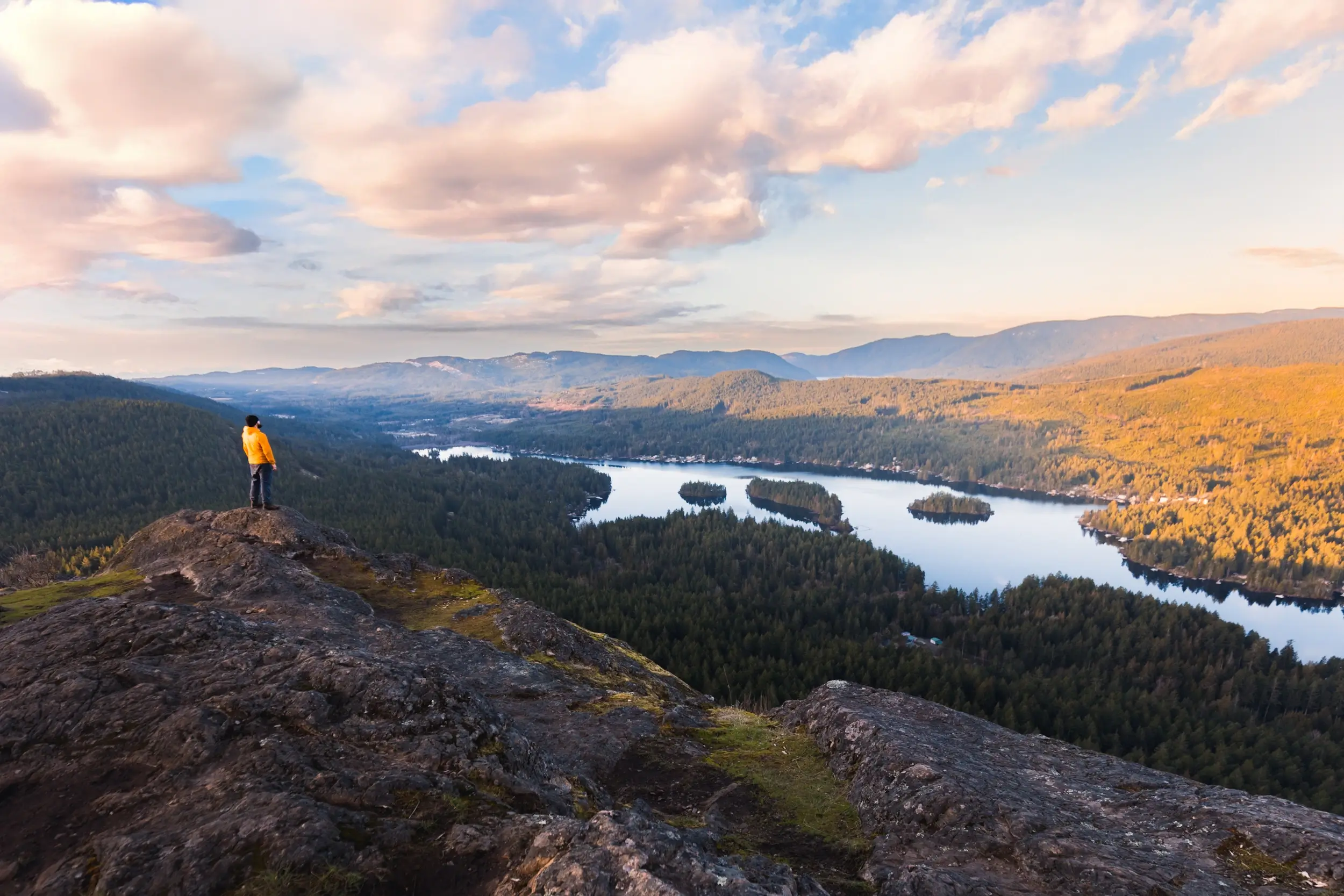
Views overlooking Shawnigan Lake from Old Baldy Mountain
I might be the wrong person to ask about hiking resources for Vancouver Island, as I am going to be highly biased towards recommending my own hiking website. Here on Seeing the Elephant I’m trying to work my way through as many of the Island’s trails as I can, but there are still way more to go. Fortunately there are a number of other great resources available, many of which I have used.
Backroads Mapbook is the bible of exploring Canadian backcountry, and the Vancouver Island edition can be found in nearly every backcountry explorer’s vehicle. It’s one of the best map resources for navigating Vancouver Island’s complex logging roads.
The Vancouver island Trails Information society series of hiking books has been one of the most popular resources for hiking on Vancouver Island for forty years, and has seen many revisions and updates in that time. Hiking Trails 1 focusses on Southern Vancouver Island, Greater Victoria and Vicinity, Hiking Trails 2 focusses on South-Central Vancouver Island and the Gulf Islands, and Hiking Trails 3 focusses on North Vancouver Island.
Theo Dombrowski is one of the most prolific Vancouver island guidebook writers, and his works include Seaside Walks on Vancouver Island, Popular Day Hikes: Vancouver Island, and Family Walks and Hikes of Vancouver Island, and the Secret Beaches of Vancouver Island series.
Backpacking on Vancouver Island by Taryn Eyton is one of the newest and most up-to-date resource for Vancouver Island hikes. Taryn also runs Happiest Outdoors, a great hiking website with a number of local hikes on it.

I wish I could hike with you!!